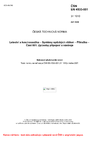ČSN EN 4533-001 (311910) Aktuální vydání
Letectví a kosmonautika - Systémy optických vláken - Příručka - Část 001: Způsoby připojení a nástroje
Anotace obsahu normy
Part 001 of EN 4533 examines the termination of optical fibre cables used in aerospace applications. Termination is the act of installing an optical terminus onto the end of a buffered fibre or fibre optic cable. It encompasses several sequential procedures or practices. Although termini will have specific termination procedures, many share common elements and these are discussed in this document. Termination is required to form an optical link between any two network or system components or to join fibre optic links together.
The fibre optic terminus features a precision ferrule with a tight tolerance central bore hole to accommodate the optical fibre (suitably bonded in place and highly polished). Accurate alignment with another (mating) terminus will be provided within the interconnect (or connector) alignment mechanism. As well as single fibre ferrules, it is noted that multi-fibre ferrules exist (e.g. the MT ferrule) and these will also be discussed in this part of the handbook.
Another technology used to connect 2 fibres is the expanded beam. 2 ball lenses are used to expand, collimate and then refocus the light from and to fibres. Contacts are not mated together. It helps reducing the wear between 2 contacts and allows more mating cycles. This technology is less sensitive to misalignments and dust. Losses are remaining more stable than butt joint contact even if the nominal loss is higher.
NOTE - Current terminology in the aerospace fibre optics community refers to an optical terminus or termini. The term optical contact may be seen in some documents and has a similar meaning. However, the term contact is now generally reserved for electrical interconnection pins. The optical terminus (or termini) is housed within an interconnect (connector is an equivalent term). Interconnects can be single-way or multi-way. The interconnect or connector will generally house the alignment mechanism for the optical termini (usually a precision split-C sleeve made of ceramic or metal). The reader should be aware of these different terms.
An optical link can be classified as a length of fibre optic cable terminated at both ends with fibre optic termini. The optical link provides the transmission line between any two components via the optical termini which are typically housed within an interconnecting device (typically a connector) with tight tolerancing within the alignment mechanisms to ensure a low loss light transmission.
Part 001 will explain the need for high integrity terminations, provide an insight into component selection issues and suggests best practice when terminating fibres into termini for high integrity applications. A detailed review of the termination process can be found in section 4 of this part and is organised in line with the sequence of a typical termination procedure.
The vast number of cable constructions and connectors available make defining a single termination instruction that is applicable to all combinations very difficult. Therefore, this handbook concentrates on the common features of most termination practices and defining best practice for current to near future applications of fibre optics on aircraft. This has limited the studies within this part to currently available 'avionic' silica fibre cables and adhesive filled butt-coupled type connectors. Many of the principles described however would still be applicable for other termination techniques. Other types of termination are considered further in the repair part of this handbook.
It is noted that the adhesive based pot-and-polish process is applicable to the majority of single-way fibre optic interconnects connectors and termini for multi-way interconnects and connectors. They share this commonality.
In order to implement a fibre optic based system on an aircraft it is vital to ensure that all the constituent elements of the system will continue to operate, to specification, over the life of the system. An important aspect of this requirement is the need for reliable interconnection components. Interconnects are a key component in any fibre optic system or network. Digital communications links, sensor systems, entertainment systems etc. all require interconnects both at equipment interfaces and for linking cables and harness sections together over the airframe.
Interconnects need to be robust to mating and demating operations, environmental changes and also the effects of contamination. They need to be amenable to inspection and cleaning for through life support.
The choice of technology used in optical links and connections is mainly dependant of the environment. In service performance is a pillar in the component selection. Cable to connector interface needs to be assessed to prove the effectiveness of the solution.
High integrity terminations are required to ensure reliable, low loss light transmission through the interconnection. High integrity terminations are produced by observing best practice and using the correct materials, tools and procedures with appropriate controls.
| Označení | ČSN EN 4533-001 (311910) |
|---|---|
| Katalogové číslo | 510390 |
| Cena | 945 Kč945 |
| Datum schválení | 1. 9. 2020 |
| Datum účinnosti | 1. 10. 2020 |
| Jazyk | angličtina (obsahuje pouze anglický originál) |
| Počet stran | 116 stran formátu A4 |
| EAN kód | 8596135103904 |
| Tato norma nahradila | ČSN EN 4533-001 (311910) z ledna 2007 |
| Dostupnost | skladem (tisk na počkání) |
Další příbuzné normy
ČSN EN 4533-002 (311910)
Letectví a kosmonautika - Systémy optických vláken - Příručka - Část 002: Zkoušky a měření
ČSN EN 4533-003 (311910)
Letectví a kosmonautika - Systémy optických vláken - Příručka - Část 003: Způsoby spojování a montáže
ČSN EN 4533-004 (311910)
Letectví a kosmonautika - Systémy optických vláken - Příručka - Část 004: Oprava, údržba, čištění a inspekce


